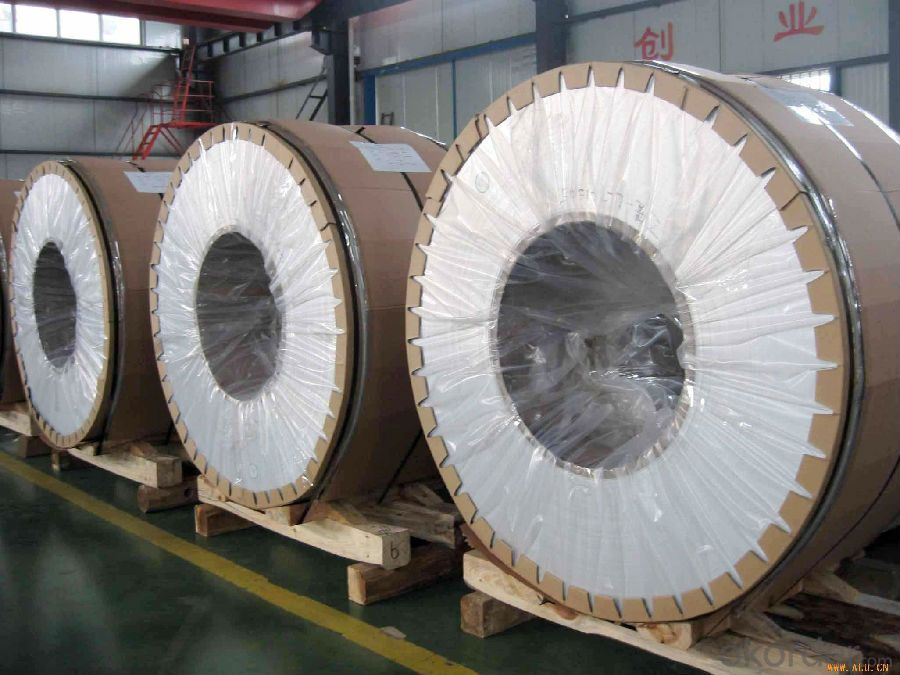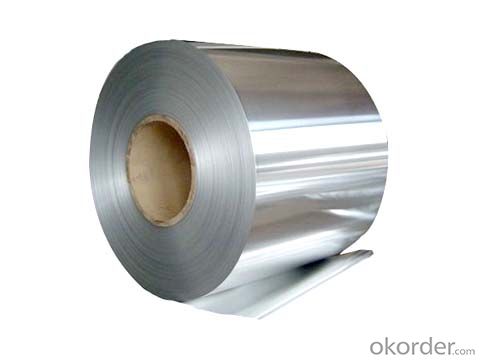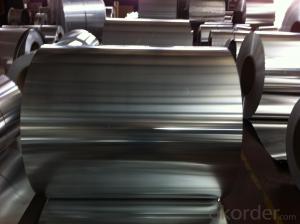Continuous Casting Aluminium Coil AA1050 HO 3mm
- Loading Port:
- Shanghai
- Payment Terms:
- TT OR LC
- Min Order Qty:
- 5 m.t.
- Supply Capability:
- 50000 m.t./month
OKorder Service Pledge
OKorder Financial Service
You Might Also Like
Item specifice
1.Structure of Product Description
Continuous Casting Aluminium Coil is one semi-finished aluminium material. The coils are widly used in the building,decoration and aluminium circle. The alloy AA1050 is the most common alloy in the aluminium industry. Its weight is much lower than steel. So many customers choosed aluminium material instead of steel.
2. Main features of the product
a.Competitive price---We have our own mills and can produce mill finished aluminium coils, so we can control the production cost better.
b.Professional after-sale service---We have more than 15 years exportation experience and you need not worry about the exporation problems.
c.Fast delivery time---We can control the delivery time within 35 days.
3. Image



4. Product Specification
| Alloy | Temper | Thickness | Width | Weight |
| AA1050 | HO | 0.2MM-3MM | 1000-1500MM | Max 3 tons |
5.FAQ:
What is the quality standard?
---Usually our standard is GB3880-2006
What is the largest width?
---It is 2300mm
What is the MOQ?
---Usually we can accept 80 tons.
- Q:Wonderland is the hard aluminum with what tools do? Thank you
- Wrought iron platform made 3 aluminum alloy with a hard aluminumAluminum + granite can also be synthesized
- Q:How are aluminum sheets cleaned and maintained?
- Achieving effective cleanliness and maintenance for aluminum sheets can be accomplished through a straightforward process. To commence, it is crucial to eliminate any loose dirt or debris from the sheet's surface. This can be accomplished by utilizing a soft brush or cloth to gently sweep away the particles. Subsequently, a mild detergent solution can be concocted by combining a small quantity of dish soap or a specialized aluminum cleaner with warm water. This solution ought to be applied to the sheets utilizing a soft sponge or cloth. It is essential to steer clear of abrasive materials or cleaners containing harsh chemicals, as these may inflict harm upon the aluminum surface. Once the detergent solution has been applied, the sheets should be thoroughly rinsed with clean water to eradicate any residue. It is pivotal to guarantee the complete removal of all soap or cleaner, as any remaining residue could result in staining or discoloration over time. Upon ensuring the sheets are clean, they should be dried using a clean, soft cloth or towel. This measure aids in preventing the formation of water spots or streaks on the surface. It is imperative to refrain from utilizing abrasive materials or engaging in vigorous rubbing, as this could lead to scratches on the aluminum. Regarding maintenance, it is advisable to regularly inspect the aluminum sheets for any indications of damage or corrosion. If any areas are discovered to be compromised, immediate repair or replacement should be undertaken to prevent further deterioration. Furthermore, applying a protective coating to the aluminum sheets is advantageous. This can be achieved by employing a specialized aluminum sealant or a clear lacquer. Such a coating serves to safeguard the surface against environmental factors like moisture, sunlight, and pollutants. In conclusion, the process of cleaning and maintaining aluminum sheets necessitates gentle and regular cleaning with a mild detergent solution, thorough rinsing, and drying with a soft cloth. Additionally, inspecting for damage and applying a protective coating can contribute to extending the longevity and enhancing the appearance of the sheets.
- Q:Can aluminum sheets be used for chemical distillation columns?
- Yes, aluminum sheets can be used for chemical distillation columns, particularly for low temperature and non-corrosive processes. However, it is important to note that aluminum may not be suitable for high temperature or corrosive applications, as it can react with certain chemicals and corrode. In such cases, alternative materials like stainless steel or glass may be more appropriate.
- Q:Can 101 aluminum sheets be used in food storage containers?
- No, 101 aluminum sheets should not be used in food storage containers. Aluminum sheets, commonly known as 101 aluminum, are not food-grade materials. They are typically used in industrial applications such as roofing, construction, and electrical wiring. Food storage containers need to be made of food-grade materials that are safe for storing and preserving food. It is recommended to use containers made of stainless steel, glass, or food-grade plastic for food storage to ensure the safety and quality of the stored food.
- Q:The only materials i can use is iodine, water, HCl, magnet, and pH paper. How do you identify aluminum with that?
- To start with, are you refering to aluminum as metal, an aluminum compound, or a solution with aluminum present as ions? If it is metaallic aluminum, it won't stick to a magnet, and it will react with HCl, however this isn't sufficient to definately say it is aluminum, it would be better to get a density, melting point, etc.
- Q:What are the different methods for finishing the edges of aluminum sheets?
- There are several methods for finishing the edges of aluminum sheets, including deburring, chamfering, filing, sanding, and using edge trims or edge guards.
- Q:Can aluminum sheets be used for railway carriages?
- Yes, aluminum sheets can be used for railway carriages. Aluminum is a lightweight and durable material that offers numerous advantages, such as corrosion resistance, energy efficiency, and ease of fabrication. It has been increasingly utilized in the construction of railway carriages due to its strength-to-weight ratio, which allows for improved fuel efficiency and higher payload capacity.
- Q:Are aluminum sheets suitable for hydraulic applications?
- Indeed, aluminum sheets prove to be fitting for hydraulic applications. Being both lightweight and resistant to corrosion, aluminum serves as a remarkable option for hydraulic systems. Its commendable thermal conductivity aids in effectively dispersing heat produced during hydraulic operations. Furthermore, aluminum sheets can be effortlessly shaped and machined to fulfill precise design needs, rendering them adaptable for an array of hydraulic components including reservoirs, tanks, and piping systems. Nevertheless, it is crucial to bear in mind the pressure and temperature prerequisites of the hydraulic application, given that aluminum possesses inferior strength and melting point in comparison to metals like steel.
- Q:Are aluminum sheets suitable for insulation and soundproofing?
- No, aluminum sheets are not suitable for insulation and soundproofing as they are not effective in blocking heat transfer or sound waves.
- Q:What are the different methods of surface cleaning for aluminum sheet?
- Different methods exist for cleaning aluminum sheets, each with unique advantages and suitability for various situations. Common methods include: 1. Mechanical Cleaning: Scrubbing the aluminum sheet with abrasive materials like sandpaper or wire brushes can physically eliminate dirt, oxidation, or other contaminants. Although effective for removing severe stains or corrosion, this method may cause scratches. 2. Chemical Cleaning: Utilizing cleaning agents or solvents, chemical cleaning dissolves and eliminates dirt, grease, or oxidation from the aluminum sheet. Depending on requirements, the cleaning agents can be acidic, alkaline, or neutral. This method is ideal for removing light stains or surface oxidation and is suitable for large-scale cleaning operations. 3. Electrolytic Cleaning: By immersing the aluminum sheet in an electrolyte solution and applying a direct current, electrolytic cleaning uses electricity to dissolve and separate contaminants from the surface. This method is effective for eliminating heavy oxidation, corrosion, or stubborn stains. 4. Ultrasonic Cleaning: Placing the aluminum sheet in a tank filled with a cleaning solution and subjecting it to high-frequency sound waves, ultrasonic cleaning creates tiny bubbles that dislodge dirt particles upon contact with the sheet's surface. It is suitable for removing fine particles, oils, or grease. 5. Steam Cleaning: High-pressure steam is employed in steam cleaning to remove dirt, grime, or contaminants from the aluminum sheet's surface. The steam's high temperature and pressure break down dirt particles and sanitize the sheet. This method effectively removes oils, greases, or organic residues. When selecting a cleaning method for aluminum sheets, factors such as the type and severity of contamination, desired cleanliness level, and specific application requirements must be considered. Additionally, it is crucial to follow safety guidelines and use appropriate protective equipment when handling cleaning agents or working with electrical equipment.
1. Manufacturer Overview |
|
|---|---|
| Location | |
| Year Established | |
| Annual Output Value | |
| Main Markets | |
| Company Certifications | |
2. Manufacturer Certificates |
|
|---|---|
| a) Certification Name | |
| Range | |
| Reference | |
| Validity Period | |
3. Manufacturer Capability |
|
|---|---|
| a)Trade Capacity | |
| Nearest Port | |
| Export Percentage | |
| No.of Employees in Trade Department | |
| Language Spoken: | |
| b)Factory Information | |
| Factory Size: | |
| No. of Production Lines | |
| Contract Manufacturing | |
| Product Price Range | |
Send your message to us
Continuous Casting Aluminium Coil AA1050 HO 3mm
- Loading Port:
- Shanghai
- Payment Terms:
- TT OR LC
- Min Order Qty:
- 5 m.t.
- Supply Capability:
- 50000 m.t./month
OKorder Service Pledge
OKorder Financial Service
Similar products
New products
Hot products
Related keywords





























